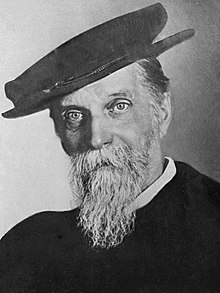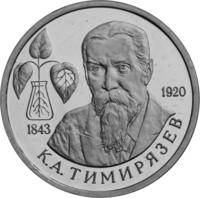Biography
Timiryazev was born to Arkady Semyenovich Timiryazev, a Russian statesman, and Adelaida Bode, an English woman of French origin, who later received Russian citizenship. He had at least three brothers: Nikolai (1835–1906), a military officer, Dimitri (1837–1903), a specialists in statistics, and Vasily (c. 1840–1912), a writer. Timiryazev was first educated by private teachers at home. In 1861 he entered the Saint Petersburg University and graduated with honors from the faculty of physics and mathematics in 1866. Two years later he published his first article, on a device for studying breakdown of carbon dioxide, and was sent abroad, where he studied under Wilhelm Hofmeister, Robert Bunsen, Gustav Kirchhoff, Marcellin Berthelot, Hermann von Helmholtz, Jean-Baptiste Boussingault and Claude Bernard. Upon returning to Russia in 1871 he defended a PhD on spectral analysis of chlorophyll and was appointed as professor of Petrov's Academy of Agriculture, until its closure in 1892. Since 1877 he also lectured at the Moscow State University. His research work was devoted to photosynthesis-related phenomena. He also pioneered the use of greenhouses for agricultural research in Russia, which he initiated in early 1870s. He was a member of the Russian Academy of Sciences (since 1890), Royal Society (1911) and Botanical Society of Scotland (1911), and an honorary professor of the Saint Petersburg University, Kharkov University, University of Glasgow (1901), University of Cambridge (1909) and University of Geneva (1909).
In 1911 Timiriazev put forth the idea of organizing scientific research in special institutes outside the universities, which later became the dominant Soviet trend. Shortly before his death in 1920, he publicly endorsed the Bolshevik regime, thus helping to forge the pact between research-oriented scientists and the Soviet government.

